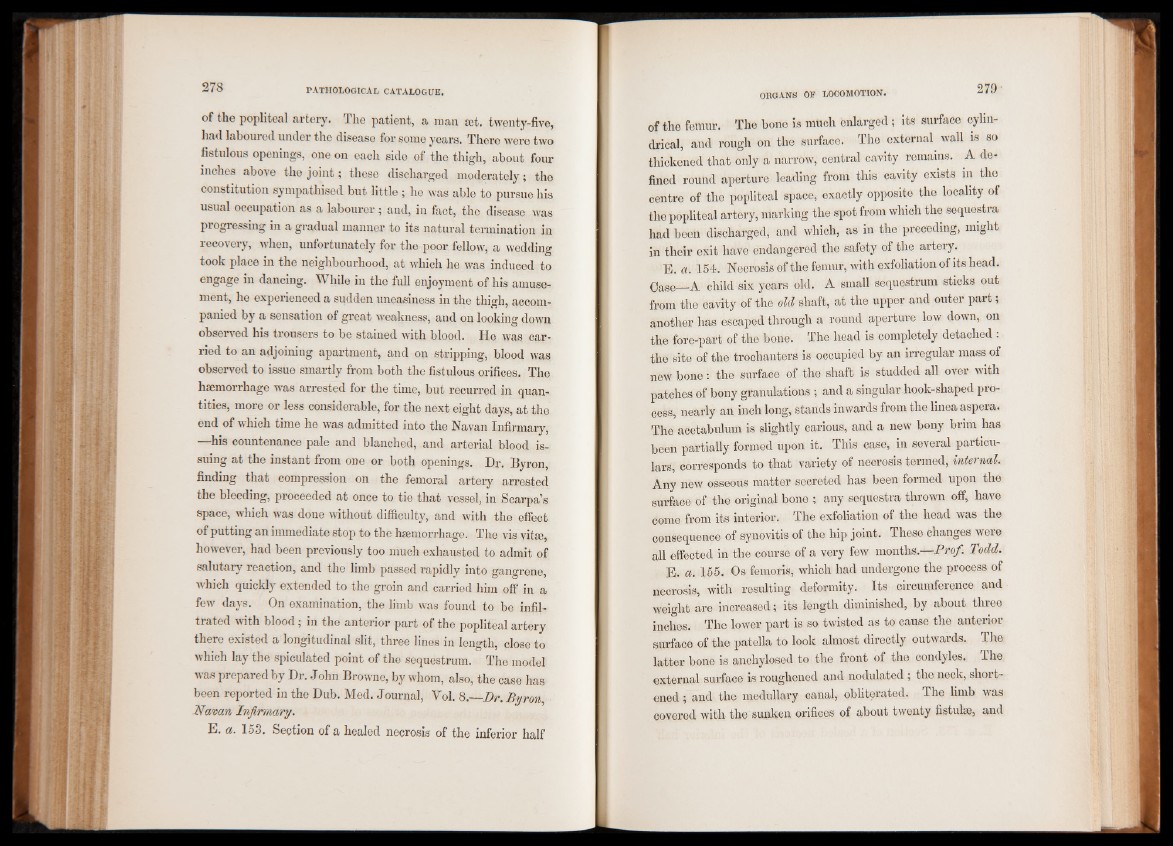
of the popliteal artery. The patient, a man set. twenty-five,
had labom ed under the disease for some years. There were two
fistulous openings, one on each side of the thigh, about four
inches above the joint; these discharged moderately; the
constitution sympathised but little; he was able to pursue his
usual occupation as a labourer; and, in fact, the disease was
progressing in a gradual manner to its natural termination in
recovery, when, unfortunately for the poor fellow, a wedding
took place in the neighbourhood, at which he was induced to
engage in dancing. While in the full enjoyment of his amusement,
he experienced a sudden uneasiness in the thigh, accompanied
by a sensation of great weakness, and on looking down
observed his trousers to be stained with blood. He was carried
to an adjoining apartment, and on stripping, blood was
observed to issue smartly from both the fistulous orifices. The
haemorrhage was arrested for the time, but recurred in quantities,
more or less considerable, for the next eight days, at the
end of which time he was admitted into the Navan Infirmary,
—his countenance pale and blanched, and arterial blood issuing
at the instant from one or both openings. Dr. Byron,
finding that compression on the femoral artery arrested
the bleeding, proceeded at once to tie that vessel, in Scarpa’s
space, which was done without difficulty, and with the effect
of putting an immediate stop to the haemorrhage,- The vis vitae,
however, had been previously too much exhausted to admit of
salutary reaction, and the limb passed rapidly into gangrene,
which quickly extended to the groin and carried him off in a
few days. On examination, the limb was found to be infiltrated
with blood, m the anterior part of the popliteal artery
there existed a longitudinal slit, three lines in length, close to
which lay the spiculated point of the sequestrum. The model
was prepared by Dr. John Browne, by whom, also, the case has
been reported in the Dub. Med. Journal, Vol. 8._Dr. Byron,
Navan Infirmary.
E. a. 153. Section of a healed necrosis of the inferior half
of the femur. The bone is much enlarged; its surface cylindrical,
and rough on the surface. The external^ wall is so
thickened that only a narrow, central cavity remains. A defined
round aperture leading from this cavity exists m the
centre of the popliteal space, exactly opposite the locality of
the popliteal artery, marking the spot from which the sequestra
had been discharged, and which, as in the preceding, might
in their exit have endangered the safety of the artery.
E. «. 154. N ecrosis of the fem ur, with exfoliation of its head.
Case—A child six years old. A small sequestrum sticks out
from the cavity of the old shaft, at the upper and outer part,
another has escaped through a round aperture low down, on
the fore-part of the bone. The head is completely detached :
the site of the trochanters is occupied by an irregular mass of
new bone: the surface of the shaft is studded all over with
patches of bony granulations ; and a singular hook-shaped process,
nearly an inch long, stands inwards from the linea aspera.
The acetabulum is slightly carious, and a new bony brim has
been partially formed upon it. This case, in several particulars,
corresponds to that variety of necrosis termed, internal
Any new osseous matter secreted has been formed upon the
surface of the original bone ; any sequestra thrown off, have
come from its interior. The exfoliation of the head was the
consequence of synovitis of the hip joint. These changes were
all effected in the course of a very few months.—Prof. Todd.
E. a. 155. Os femoris, which had undergone the process of
necrosis, with resulting deformity. Its circumference and
weight are increased; its length diminished, by about three
inches. The lower part is so twisted as to cause the anterior
surface of the patella to look almost directly outwards. The
latter bone is anchylosed to the front of the condyles. The
external surface is roughened and nodulated ; the neck, shortened
; and the medullary canal, obliterated. The limb was
covered with the sunken orifices of about twenty fistula?, and